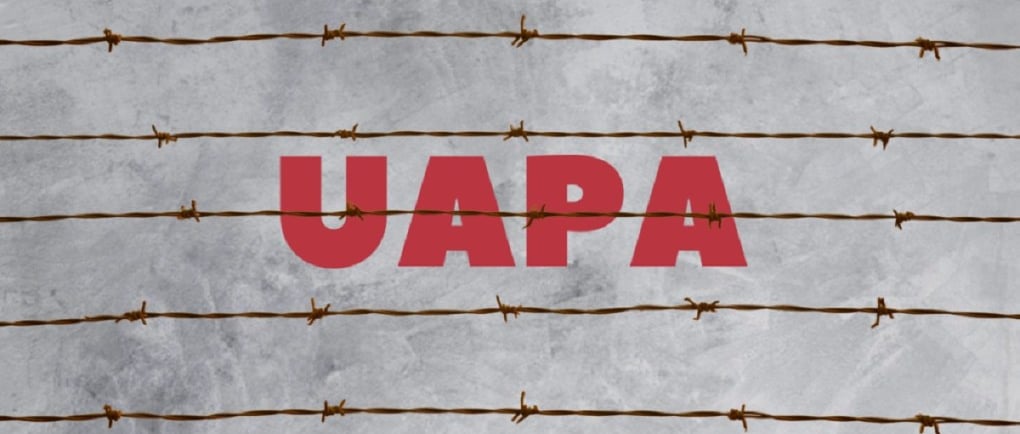Comprehensive Summary of UAPA
M.S. Husain, Advocate
10/8/20256 min read


Unlawful Activities (Prevention) Act, 1967 (UAPA) — Comprehensive Summary
1. Overview and Objectives
[1] Purpose
Provide for the more effective prevention of certain unlawful activities of individuals and associations.
Deal with terrorism-related activities, financing of terrorism, and threats to India’s sovereignty and integrity.
Enable proscription (ban) of organizations and, since 2019, designation of individuals as terrorists.
Facilitate investigation, prosecution, and adjudication with a specialized, stringent framework.
[2] Applicability
Extends to the whole of India; certain provisions apply extraterritorially to Indian citizens outside India, persons on Indian-registered ships/aircraft, and offences with a nexus to India.
2. Key Definitions and Scope
[1] Unlawful Activity (Section 2(o))
Any action (by words, signs, or visible representation) intended to bring about cession/secession of Indian territory, disrupt sovereignty/integrity, or cause disaffection against India.
[2] Unlawful Association (Section 2(p))
An association that encourages or aids unlawful activities or has for its object any unlawful activity.
[3] Terrorist Act (Section 15)
Use or threat of use of specified means (e.g., bombs, firearms, hazardous substances) with intent to threaten the unity, integrity, security, or sovereignty of India, or to strike terror in people; includes damage to property, disruption of essential services, and acts likely to cause death/injuries.
[4] Terrorist Organisation (Section 2(m), Schedule)
Organisations listed in the First Schedule; membership, support, or association entails offences under Chapter VI.
[5] Terrorist Gang/Individual Terrorist (Sections 2(l), 35)
2019 amendment permits designation of individuals as terrorists by inclusion in the Fourth Schedule.
3. Institutional and Executive Powers
[1] Central Government (MHA)
Power to declare an association unlawful (Section 3) and to constitute Tribunals to adjudicate bans (Sections 4–7).
Power to add or remove organizations/individuals to/from the terrorist lists (Section 35), subject to review.
[2] Tribunal (Unlawful Activities)
A sitting High Court Judge decides whether the notification declaring an association unlawful is justified, within prescribed timelines.
[3] National Investigation Agency (NIA) and State Police
Investigate UAPA offences; NIA can take over cases of national importance.
Director General, NIA authorized to approve seizure/attachment of property (Section 25).
4. Core Substantive Offences
[1] Unlawful Activities (Chapter II)
Penalties for taking part in, assisting, managing, or contributing to unlawful associations and activities.
[2] Terrorism Offences (Chapter IV)
Commission, conspiracy, attempt, abetment, and support of terrorist acts (Sections 15–23).
Offences include raising funds for terrorism (Section 17), holding proceeds of terrorism (Section 21), organizing terrorist camps (Section 18A), and recruitment (Section 18B).
[3] Terrorist Organisations and Membership (Chapter VI)
Membership, support, or association with a listed terrorist organisation (Sections 38–40).
Offences for inviting support, organizing meetings, or addressing such meetings.
[4] Financing of Terrorism and Property (Sections 17, 18, 21, 24–25)
Criminalizes collection/provision of funds or property for terrorist acts or organizations, with powers to seize/forfeit proceeds of terrorism.
5. Penalties and Sentencing
[1] Punishments
Range from fine to life imprisonment or death (for the gravest acts causing death).
Terror financing and key facilitation offences carry rigorous imprisonment and fine.
[2] Enhanced Punishment for Repeat Offences
Repeat convictions attract higher penalties, including life imprisonment.
6. Procedural Features and Safeguards
[1] Cognizable and Non-bailable
Most UAPA offences are cognizable and non-bailable with stringent bail thresholds (Section 43D(5)).
[2] Arrest, Search, and Seizure (Chapter VI-A; Sections 43A–43F)
Special powers analogous to, but distinct from, CrPC (now BNSS); admissibility of certain evidence and extended detention/remand timelines.
[3] Sanction for Prosecution (Section 45)
Prior sanction of the Central or State Government is required for prosecution; independent review by an authority before sanction.
[4] Extended Time for Investigation (Section 43D(2))
Permits up to 180 days for filing charge-sheet upon judicial authorization, instead of the typical 90 days.
[5] Presumptions (Section 43E)
Presumptions regarding offences under UAPA in certain circumstances (e.g., possession of arms/explosives under specified conditions).
[6] Forfeiture and Attachment (Sections 24–25)
Property used for, or derived from, terrorism can be seized/forfeited with approvals.
7. Designation and Proscription Mechanism
[1] Unlawful Association (Sections 3–7)
Central Government may declare an association unlawful; Tribunal review within a fixed timeframe; the ban can be confirmed, modified, or set aside.
[2] Terrorist Organisations (First Schedule; Section 35)
Additions through notification; grounds include involvement in terrorism.
Review mechanism allows applications for de-listing and periodic review by the Review Committee.
[3] Individual Terrorists (Fourth Schedule; Section 35, 36)
Since 2019, individuals can be designated as terrorists; they can seek removal via application to the Central Government and appeal to a Review Committee.
8. Bail Framework and Pre-trial Detention
[1] Section 43D(5)
Bail must be denied if the court finds reasonable grounds for believing the accusation is prima facie true.
This is a high threshold; courts examine the case diary, charge-sheet, and materials without detailed evaluation of evidence.
[2] Special Considerations
Juveniles and women may receive sympathetic consideration consistent with general criminal law but subject to UAPA constraints.
House arrest and electronic monitoring are rare and case-specific judicial orders.
9. Interaction with General Criminal Law
[1] CrPC and Evidence Act
CrPC applies unless inconsistent with UAPA’s special provisions.
Certain evidentiary presumptions and extended time limits override general law.
[2] Overlap with Other Statutes
NDPS Act, PMLA, Arms Act, Explosive Substances Act, and IT Act may run concurrently where factual matrices overlap (e.g., terror financing via laundering).
10. Significant Judicial Pronouncements
[1] National Investigation Agency v. Zahoor Ahmad Shah Watali (2019)
Set the standard for bail under Section 43D(5): courts must only assess whether accusations are prima facie true; detailed scrutiny or weighing of evidence is impermissible at the bail stage.
Elevated the bar for bail in terror-financing and conspiracy cases.
[2] Union of India v. K.A. Najeeb (2021)
Recognized constitutional courts’ powers to grant bail on grounds of prolonged incarceration and trial delays, notwithstanding Section 43D(5), to uphold Article 21 (right to speedy trial).
[3] Thwaha Fasal v. Union of India (2021)
Clarified that mere possession of literature or ideological sympathy is insufficient; there must be overt acts or association with intention to further unlawful/terrorist activities for offences under Sections 38–39.
[4] Vernon Gonsalves & Arun Ferreira v. State of Maharashtra (2023)
Reiterated the need to distinguish between protected speech/association and actionable support; bail granted noting absence of prima facie case under stringent UAPA standards for certain allegations.
[5] State of Kerala v. Raneef (2011)
Emphasized caution in criminalizing mere association; courts should require a nexus between the accused’s conduct and unlawful/terrorist activities.
[6] Shreya Singhal v. Union of India (2015) — Contextual
While not a UAPA case, it underscored protection of speech under Article 19(1)(a), informing how courts examine speech-based UAPA allegations.
[7] Recent High Court Trends
Several High Courts have scrutinized sanction orders, adherence to Section 45 review, and the sufficiency of material for prima facie true findings, sometimes granting bail where materials were speculative or purely associational.
Note: Case law continues to evolve; always consult the latest Supreme Court/High Court rulings for current positions on bail, mens rea, and free speech boundaries.
11. Amendments and Evolution
[1] 2004 and 2008 Amendments
Introduced comprehensive terrorism chapters after POTA’s repeal; expanded definitions, investigative powers, and schedules.
[2] 2012 Amendment
Strengthened terror financing provisions, search/seizure powers, and cross-border applicability.
[3] 2019 Amendment
Enabled designation of individuals as terrorists; expanded seizure/attachment authorities (e.g., DG, NIA); widened ambit for investigations.
12. Practical Application and Enforcement
[1] Investigative Focus
Conspiracies, terror modules, cross-border linkages, digital communication evidence, and financing streams via hawala, NGOs, trade-based methods, virtual assets.
[2] Common Prosecution Strategies
Use of protected witnesses, digital forensics, financial trails, call data records, and Section 43E presumptions.
[3] Defence Strategies
Challenge “prima facie true” finding with specific infirmities; question sanction validity and independence; emphasize lack of overt acts or intent; assert Article 19/21 violations where applicable; highlight prolonged incarceration and trial delays.
[4] Compliance for NGOs/Entities
Robust FCRA compliance (if applicable), transparent accounting, donor due diligence, governance controls, documented program expenditures, and immediate reporting of suspicious activities.
13. Penalties, Forfeiture, and Collateral Consequences
[1] Criminal Penalties
Rigorous imprisonment up to life or death (for the gravest acts), and fines.
[2] Property Measures
Seizure/forfeiture of property used in or derived from terrorism; attachment orders by empowered officers.
[3] Collateral Effects
Travel restrictions, asset freezes, reputational damage, debarment from funding, and enhanced regulatory scrutiny.
14. Key Takeaways
[1] UAPA is a stringent national security statute with expansive definitions and severe bail constraints.
[2] The prosecution must show intent and actionable nexus for speech/association-based offences; mere ideology is insufficient.
[3] Bail remains difficult under Section 43D(5), but constitutional courts can intervene for prolonged incarceration and procedural lapses.
[4] Meticulous compliance, transparent finances, and documented activities are essential for NGOs and entities to mitigate risk.
15. Quick Reference
Provision/ Authority : Aspect : Core Point
[1] Section 2(o) : Unlawful activity definition : Acts undermining sovereignty/integrity; secession/cession.
[2] Section 3 : Declare association unlawful : Central Govt. notification; Tribunal review.
[3] Section 15 : Terrorist act : Acts/intents threatening unity/security or striking terror.
[4] Section 17 : Terror financing : Raising/collecting funds for terrorism is an offence.
[5] Sections 21, 24–25 : Proceeds/property : Seizure/forfeiture; DG NIA approval for attachment.
[6] Section 43D(5) : Bail bar : Deny bail if accusations are prima facie true.
[7] Section 43D(2) : Extended investigation : Up to 180 days to file charge-sheet.
[8] Section 35, Fourth Schedule : Individual designation : Govt. may list individuals as terrorists; review available.
[9] Section 45 : Sanction for prosecution : Prior sanction with independent review.
[10] NIA/State Police : Investigating agency : NIA can take over and supervise national-importance cases.
